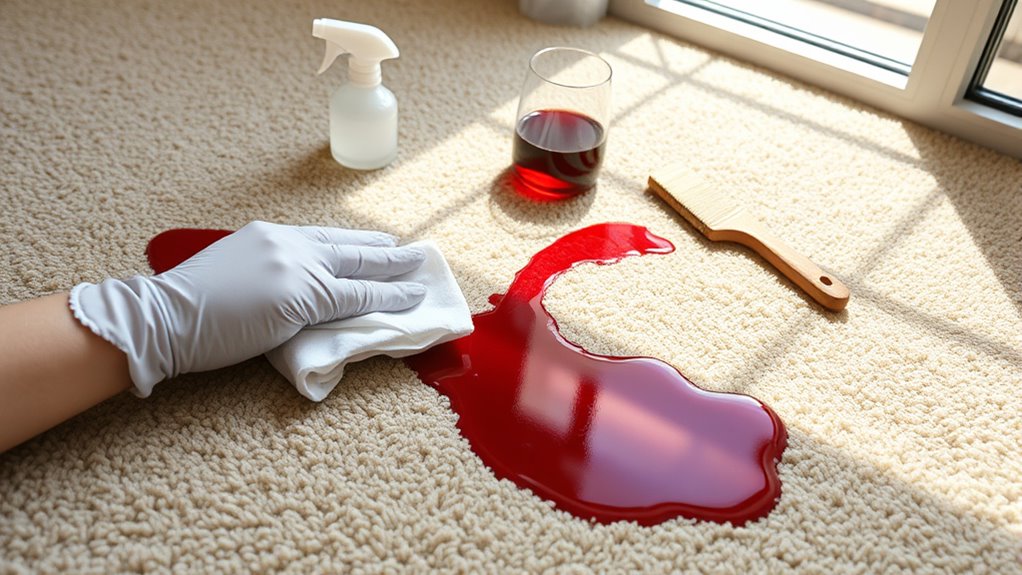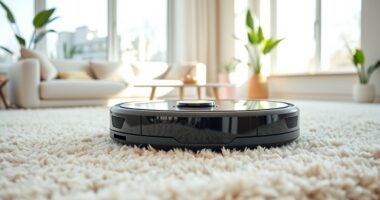To keep your carpet clean and fresh, vacuum regularly, especially in high-traffic areas, to remove dirt and dust before they settle deep. Address spills immediately by blotting and applying suitable cleaners, testing solutions first to prevent damage. Deep clean with steam or hot water extraction every 12-18 months to remove deep-seated dirt. Use baking soda for odor control, and protect high-traffic zones with rugs or shields. Proper techniques and tools can boost carpet longevity—discover more tips to maintain your carpet’s beauty.
Key Takeaways
- Vacuum regularly, especially in high-traffic areas, to prevent dirt buildup and extend carpet lifespan.
- Address spills immediately by blotting and applying suitable cleaners to prevent stains from setting.
- Use deep cleaning techniques like hot water extraction periodically to remove deep-seated dirt and allergens.
- Test cleaning solutions on small areas first to ensure they won’t damage fibers or cause discoloration.
- Incorporate odor absorbers like baking soda and schedule professional cleanings every 12-18 months for optimal maintenance.
Regular Vacuuming for Daily Maintenance

Regular vacuuming is essential for maintaining a clean and healthy carpet daily. Consistent vacuum maintenance helps prevent dirt, dust, and debris from settling deep into the fibers, which can cause wear over time. By removing daily debris, you keep your carpet looking fresh and extend its lifespan. Make it a habit to vacuum high-traffic areas more frequently to reduce buildup. Use a vacuum with strong suction and proper attachments to ensure thorough cleaning. Don’t forget to adjust the height setting for different carpet types, which improves efficiency. Regular vacuuming not only improves indoor air quality but also minimizes allergens that can affect your health. Staying consistent with your vacuum routine is a simple yet effective way to keep your carpet in top condition. Additionally, choosing a vacuum with appropriate filtering capabilities can further enhance the removal of dust and allergens from your home. Proper vacuuming techniques can further optimize cleaning results and reduce fiber damage. Incorporating automatic vacuuming technology can also help maintain your carpet effortlessly.
Addressing Spills and Stains Immediately

When a spill occurs, acting quickly can prevent stains from setting and causing lasting damage. The key is to use effective stain removal techniques and spill prevention strategies right away. Blot the spill gently with a clean cloth to soak up excess liquid—avoid rubbing, which spreads the stain. For stubborn stains, apply a suitable cleaner promptly. Use this table to guide your response:
| Spill Type | Immediate Action |
|---|---|
| Coffee or Wine | Blot, then apply cold water |
| Grease or Oil | Sprinkle baking soda, vacuum |
| Juice or Soda | Blot, then use mild detergent |
Quick, targeted actions help keep your carpet looking fresh and stain-free longer. Additionally, being aware of common stain types can help you respond more effectively in future situations. Using appropriate cleaning solutions tailored to each stain can enhance removal success. Incorporating preventative measures can further reduce the likelihood of persistent stains. Maintaining regular cleaning routines also helps in stain prevention by reducing dirt buildup that can trap stains.
Using the Right Cleaning Solutions

To clean your carpet effectively, you need to choose the right products for the job. Always read labels carefully to understand their proper use and safety precautions. Before applying any solution widely, test a small, hidden area first to avoid damage or discoloration. Additionally, selecting products with appropriate carpet-safe ingredients can help prevent possible damage during cleaning.
Choose Appropriate Products
Choosing the right cleaning solutions is essential to effectively remove dirt and stains without damaging your carpet. To do this, focus on three key steps. 1. Detergent selection: Pick a cleaning product suited for your carpet type, ensuring it targets specific stains or dirt. 2. Chemical safety: Always opt for eco-friendly or non-toxic options to protect your family and pets from harmful fumes. 3. Test first: Before full application, test the product on a small, hidden area to check for colorfastness and avoid unexpected damage. Additionally, considering the candy varieties and innovations, some products are inspired by trends or endorsements that may influence your choice. Remember that using literary humor in your decision-making process can bring a creative perspective, making the task more enjoyable. Incorporating herbal infusion tools can also help in creating natural cleaning solutions that are gentle yet effective.
Read Labels Carefully
Reading labels carefully guarantees you’re using the right cleaning solutions for your carpet. When you read labels, you verify the product is suitable for your carpet’s fiber type, which is vital for effective cleaning and avoiding damage. Fiber identification helps you choose solutions that won’t weaken or discolor the material. Always check for specific instructions and warnings, such as whether the cleaner is safe for wool, nylon, or synthetic fibers. Using the wrong product can lead to staining, shrinking, or fiber deterioration. Additionally, product safety information on labels provides crucial details to prevent adverse reactions or damage. Paying attention to fiber type identification ensures you select the most compatible cleaning agent for your carpet. Moreover, understanding the ingredients can help you avoid harsh chemicals that might harm sensitive fibers or cause allergic reactions. By paying close attention to labels, you make informed decisions that protect your carpet’s integrity and appearance. Proper label reading also helps you choose solutions that are eco-friendly and safe for your household. Remember, proper identification and adherence to manufacturer guidelines are key steps in achieving a thorough, safe clean.
Test Spot First
Before applying any cleaning solution to your entire carpet, it is essential to test it on a small, inconspicuous area first. This testing carpet step helps prevent damage and guarantees effective stain removal. To do this:
- Choose a hidden spot and apply a small amount of the cleaning solution.
- Wait 10-15 minutes to check for discoloration or damage.
- If the carpet remains unaffected, proceed with cleaning the visible stain.
- Remember, understanding cookie consent management ensures you are aware of how your data may be used during online research or product purchases related to cleaning products.
- Being familiar with divorce processes can help you find the right legal assistance if needed for related matters.
- Additionally, understanding the power of electric dirt bikes can inform you about the importance of using appropriate cleaning solutions for different types of stains and materials.
- Staying informed about AI security vulnerabilities can help you choose safer cleaning products that do not contain harmful chemicals or ingredients.
Testing carpet solutions safeguards against unwanted reactions and confirms the solution’s effectiveness. It’s especially important when trying new stain removal products or homemade solutions. By taking this simple step, you avoid costly mistakes and ensure your carpet stays in great condition while effectively removing stains. Always remember, a small test saves a lot of trouble later.
Deep Cleaning With Steam or Hot Water Extraction

Deep cleaning your carpet with steam or hot water extraction is one of the most effective ways to remove deep-seated dirt, stains, and allergens. Steam cleaning uses high-temperature steam to loosen grime, while hot water extraction involves injecting heated water and cleaning solution into the fibers, then immediately extracting it. Both methods thoroughly clean your carpet and improve indoor air quality. When you opt for these techniques, make sure to use the right equipment and follow the manufacturer’s instructions to avoid over-wetting. Professional services often perform hot water extraction, ensuring deep penetration and efficient dirt removal. Regular deep cleaning with steam or hot water extraction keeps your carpets fresh, healthier, and looking new longer. Self Watering Plant Pots can be a helpful analogy for understanding how consistent moisture levels benefit carpet fibers and maintain their appearance. Additionally, using specialized equipment designed for deep cleaning can enhance the effectiveness of these methods. Proper carpet drying techniques are essential to prevent mold growth and prolong the carpet’s lifespan, and understanding drying methods can help ensure your carpets dry thoroughly and safely.
Avoiding Over-Wetting Your Carpets

To avoid over-wetting your carpets, make sure you use the right equipment designed for controlled water application. Limit the amount of water you use during cleaning to prevent saturation and longer drying times. Proper technique helps protect your carpet fibers and keeps your home’s interior fresh. Regularly monitoring your cleaning process can also prevent excessive moisture buildup. Additionally, choosing appropriate cleaning methods ensures that your carpets are cleaned effectively without risking damage from over-hydration. Using equipment with advanced technology can further enhance control over water usage and improve cleaning outcomes.
Use Proper Equipment
Using the right equipment is essential to prevent over-wetting your carpets. Proper tools help you control moisture and avoid damage. First, choose a vacuum with quality attachments; these help remove loose dirt efficiently without pushing excess water into your carpet fibers. Second, use vacuum attachments designed for deep cleaning to enhance soil removal. Third, consider equipment that allows you to monitor water usage, ensuring you don’t over-saturate the carpet. Additionally, equipment like a carpet stretcher can help you maintain proper fiber tension, reducing the risk of stretching or distortion caused by excess moisture. By selecting the right tools, you’ll clean more effectively, minimize water use, and keep your carpet looking its best without the mess or damage caused by over-wetting.
Limit Water Application
While it might seem effective to use plenty of water during cleaning, over-wetting your carpets can cause more harm than good. Excess water leads to water saturation, which takes longer to dry and increases the risk of mold and mildew growth. It can also cause carpet shrinkage, damaging the fibers and affecting the carpet’s appearance and durability. To avoid these issues, use minimal water during cleaning—just enough to loosen dirt without saturating the fibers. Focus on controlled application and extraction, ensuring your carpet dries quickly. Properly managing water use not only protects your carpet but also reduces the chances of mold, odors, and expensive repairs. Remember, less water often leads to better, safer cleaning results.
Incorporating Baking Soda for Odor Control

Baking soda is a simple yet effective way to neutralize odors and refresh your carpets. Its natural deodorization properties make it a go-to for odor neutralization techniques. To use it effectively, follow these steps:
Baking soda effectively neutralizes odors and refreshes carpets naturally and affordably.
- Sprinkle a generous layer of baking soda evenly across the carpet surface.
- Let it sit for at least 15 minutes, or ideally overnight, to absorb odors thoroughly.
- Vacuum the baking soda completely to remove all residues and freshen your carpet.
This method helps eliminate stubborn smells without harsh chemicals. Baking soda deodorization is safe, affordable, and simple to incorporate into your regular cleaning routine. By doing so, you’ll keep your carpets smelling fresh and clean with minimal effort.
Protecting Carpets With Area Rugs and Shields

Protecting your carpets from wear and stains is easier when you strategically place area rugs and shields in high-traffic or vulnerable spots. Proper area rug placement keeps dirt and moisture off your main carpet, reducing deep stains and wear. Choose rugs with non-slip backing to prevent slipping accidents, and position them near entryways, hallways, or under furniture that gets frequent use. Carpet shield benefits include creating a barrier against spills, mud, and pet messes, which can be tough to clean later. Using shields or pads under high-traffic areas helps distribute weight evenly, preventing uneven wear. Regularly repositioning rugs and shields also ensures even aging of your carpet, keeping it looking fresh longer. These simple steps considerably extend your carpet’s lifespan and maintain its appearance.
Scheduling Professional Cleanings for Deep Refreshing

Even with strategic placement of rugs and shields, regular deep cleaning by professionals can markedly enhance your carpet’s lifespan and appearance. Scheduling appointments with experts guarantees your carpet receives the thorough cleaning it needs. Here’s how to make the most of it:
- Determine the right frequency—typically every 12-18 months—based on foot traffic and household needs.
- Book appointments in advance to fit your schedule and secure professional expertise.
- Prepare your space by removing clutter and securing delicate items, so cleaners can work efficiently.
Frequently Asked Questions
How Often Should I Replace My Carpet to Maintain Cleanliness?
You might wonder how often you should replace your carpet to keep it clean. Typically, the carpet lifespan is about 5 to 15 years, depending on use and maintenance. Replacement frequency varies based on wear, stains, and overall condition. If your carpet shows significant damage, persistent stains, or odors despite cleaning, it’s time for replacement. Regular upkeep can extend its lifespan, but knowing when to substitute ensures a healthier, cleaner home environment.
Can Homemade Cleaning Solutions Damage Certain Carpet Fibers?
Think of DIY solutions as a double-edged sword—they can clean effectively but might also harm your carpet fibers. Some homemade cleaning chemicals contain harsh ingredients that can weaken or discolor delicate fibers, much like a rough scrubber damages soft fabric. Always research your DIY solutions and test small areas first. Using gentle, fiber-friendly ingredients helps prevent damage, ensuring your carpet stays clean and intact longer.
What Are the Signs of Mold or Mildew in Carpets?
You should look for signs of mold or mildew in carpets such as a musty smell, discoloration, or visible spots. Mold detection involves checking hidden areas like beneath rugs and along baseboards. To prevent mildew, guarantee proper ventilation and dry your carpet thoroughly after spills or cleaning. If you notice any signs, act immediately to avoid health issues and further damage, keeping your home safe and clean.
Are There Eco-Friendly Carpet Cleaning Options Available?
Imagine your carpet as a lush garden, thriving with life and color. To keep it vibrant, you can choose eco-friendly products that nurture your home and the environment. Green cleaning offers a gentle yet effective approach, using natural ingredients that eliminate dirt without harsh chemicals. With eco-friendly options, you not only safeguard your family’s health but also contribute to a healthier planet, making every step a conscious, caring choice.
How Do I Remove Pet Hair Effectively From Carpets?
To remove pet hair effectively from carpets, start by using a rubber broom or a damp rubber glove to attract hair from carpet fibers safely. Regular vacuuming with a HEPA filter cleaner also helps, but make certain it’s gentle to maintain carpet fiber safety. For stubborn hair, try a fabric softener spray before vacuuming, which loosens hair and keeps your carpet in good condition. This keeps your space clean and your carpets protected.
Conclusion
By following these tips, your carpets will stay vibrant and inviting, like a fresh bloom in spring. Think of regular maintenance as watering a garden—small, consistent efforts keep your home blooming with cleanliness. When you tackle spills quickly and use the right solutions, you’re the gardener nurturing your space. With a little care, your carpets will continue to weave warmth and comfort into your home’s fabric, making every step feel like walking on clouds.









